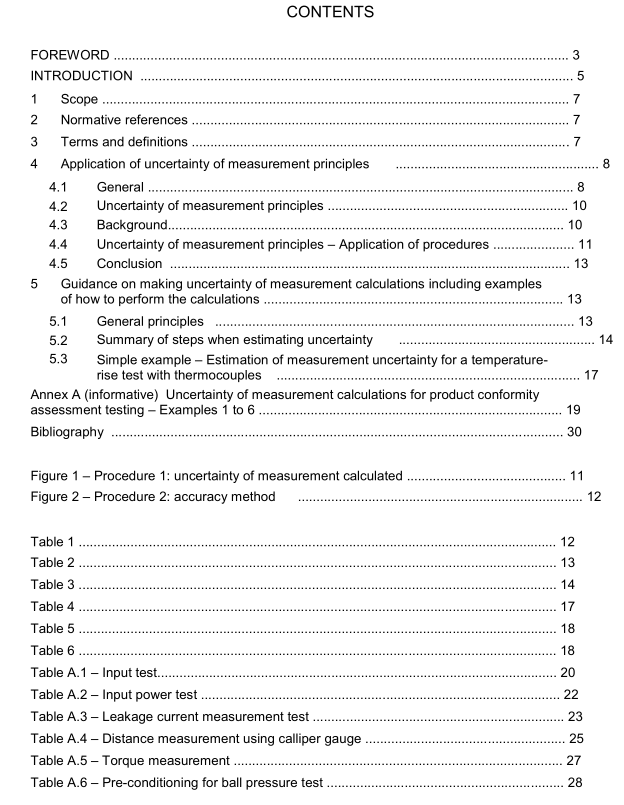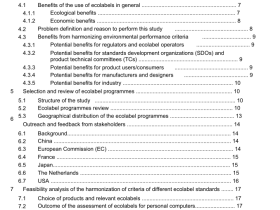IEC Guide 115 pdf – Application of uncertainty of measurement to conformity assessment activities in the electrotechnical sector

IEC Guide 115 pdf – Application of uncertainty of measurement to conformity assessment activities in the electrotechnical sector
1 Scope
This Guide presents a practical approach tothe application of uncertaintyof measurement toconformity assessment activities in the electrotechnical sector. It is specifically conceived foruse in lECEE Schemes as well as by testing laboratories engaged in testingelectricalproducts to national safety standards. lt describes the application of uncertaintyofmeasurement principles and provides guidance on making uncertainty of measurementcalculations. It also gives some examples relating to uncertainty of measurement calculations
for product conformity assessment testing.
Normative references
The following documents are referred to in the text in such a way that some or all of theircontent constitutes requirements of this document. For dated references, only the editioncited applies. For undated references, the latest edition of the referenced document (inciuding
any amendments) applies.
ISO/IEC 17025,General requirementsfor the competence of testing and calibrationlaboratories
Terms and definitions
For the purposes of this document, the following terms and definitions apply.
ISO and lEC maintain terminological databases for use in standardization at the followingaddresses:
. IEC Electropedia: available at http://www.electropedia.orgl
. Iso Online browsing platform: available at http://www.iso.orglobp
3.1
coverage factor
number that,when multiplied by the combined standard uncertainty,produces an interval(the expanded uncertainty) about the measurement result that can be expected to encompass
a large,specified fraction (e.g. 95 %) of the distribution of values that could be reasonablyattributed to the measurand
3.2
combined standard uncertainty
result of the combination of standard uncertainty components
3.3
error of measurement
result of a measurement minus a true value of the measurand
Note 1 to entry. The error of measurement is not precisely quantifiable because the true value lies somewhereunknown withinthe range of measurement uncertainty
3.4
expanded uncertainty
value obtained by multiplying the combined standard uncertainty by a coverage factor
3.5
level of confidence
probability that the value of the measurand lies within the quoted range of uncertainty
3.6
measurand
quantity subjected to measurement, evaluated in the state assumed by the measured system during the measurement itself
[SOURCE: IEC 60359:2001, 3.1.1, modified – The NOTES have been deleted.]
3.7
quantity X
source of uncertainty
i
3.8
standard deviation
positive square root of the variance
3.9
standard uncertainty
estimated standard deviation
3.10
uncertainty of measurement
parameter, associated with the result of a measurement, that characterizes the dispersion of the values that could reasonably be attributed to the measurand
[SOURCE: IEC 60359:2001, 3.1.4, modified – The NOTES have been deleted.]
3.11
Type A evaluation method
method of evaluation of uncertainty of measurement by the statistical analysis of a series of observations
3.12
Type B evaluation method
method of evaluation of uncertainty of measurement by means other than the statistical analysis of a series of observations
4 Application of uncertainty of measurement principles
General
4.1
4.1.1 Qualification and acceptance of Certification Body Testing Laboratories (CBTLs), e.g.in the IECEE, are performed according to ISO/IEC 17025.
“7.6 Evaluation of measurement uncertainty
7.6.1 Laboratories shall identify the contributions to measurement uncertainty. When evaluating measurement uncertainty, all contributions that are of significance, including those arising from sampling, shall be taken into account using appropriate methods of analysis. 7.6.2 A laboratory performing calibrations, including of its own equipment, shall evaluate the measurement uncertainty for all calibrations.
7.6.3 A laboratory performing testing shall evaluate measurement uncertainty. Where the test method precludes rigorous evaluation of measurement uncertainty, an estimation shall be made based on an understanding of the theoretical principles or practical experience of the performance of the method.
NOTE 1 In those cases where a well-recognized test method specifies limits to the values of the major sources of measurement uncertainty and specifies the form of presentation of the calculated results, the laboratory is considered to have satisfied
7.6.3 by following the test method and reporting instructions. NOTE 2 For a particular method where the measurement uncertainty of the results has been established and verified, there is no need to evaluate measurement uncertainty for each result if the laboratory can demonstrate that the identified critical influencing factors are under control.”
4.1.2 ISO/IEC 17025:2005, 5.10.3.1 c) states: “c) where applicable, a statement on the estimated uncertainty of measurement; information on uncertainty is needed in test reports, when it is relevant to the validity or application of the test results, when a customer’s instruction so requires, or when the uncertainty affects compliance to a specification limit;”. ISO/IEC17025:2017, 7.8.3.1 c) states: “c) where applicable, the measurement uncertainty presented in the same unit as that of the measurand or in a term relative to the measurand (e.g. percent) when: – it is relevant to the validity or application of the test results; – a customer’s instruction so requires, or









